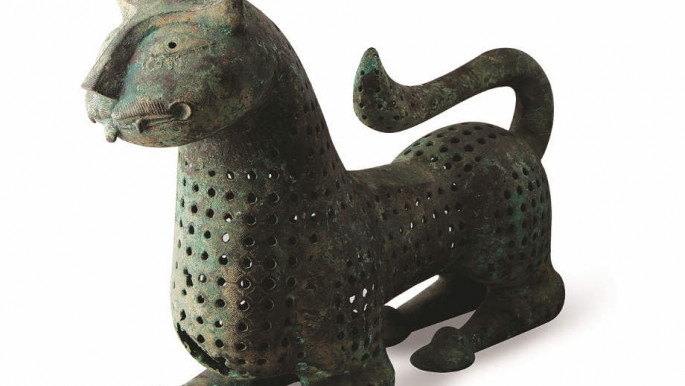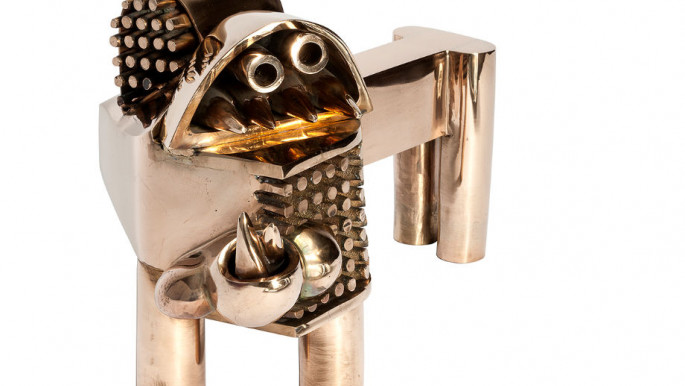
Parviz Tanavoli and his triumphant Lions of Iran
Parviz Tanavoli had more than a few initial reservations about the fate of his exhibition, the Lions of Iran. But "my efforts have been rewarded", the delighted artist told The New Arab.
On July 2, opening night at the Tehran Museum of Contemporary Art, he said: "It was so full we had to close the doors." With almost 1,000 patrons in attendance, "it was my most successful show to date," said the 80-year-old, who divides his time between Vancouver and Tehran.
Around 100 foreign guests including diplomats and gallery directors were among those in attendance. These included V&A curator Moya Carey and the director of Christie's Dubai Michael Jeha, as well as ambassadors and cultural attaches from Japan, Germany and Azerbaijan.
Unfortunately, David Galloway, the art critic and founding curator at the Tehran Museum of Contemporary Art who contributed to the exhibition catalogue, and whom Tanavoli had hoped would attend and deliver an opening speech, was denied a visa by Iranian authorities. Tanavoli says this was likely due to the reciprocal ban Iranian authorities have placed on US passport holders.
But otherwise the exhibition was not only, as TMoCA director Majid Molla-Norouzi told Tanavoli, "the most successful, significant and extensive show in our museum to date", but it was also a triumph for cultural diplomacy.
With Rouhani's victory in June elections, The Lions of Tehran was "green-lighted", says Tanavoli. "But if hardliners had won, it would not have been so easy."
The exhibition, several years in the planning, was far from an easy. Tanavoli, one of Iran's pre-eminent modern artists, wore many hats in the organising of the exhibition: curator, artist, collector, and informal diplomat as he negotiated with Iran's considerable bureaucracy to gain rare permission to exhibit treasures from both the National Museum of Iran and the Reza Abbasi Museum, named after Iran's famous 17th century poet.
 |
More than 40 historic objects went on display, including the famed golden dagger of Darius the Great as well as a golden Rhyton with a lion's head from the Achamedian era.
The exhibition occupied all nine galleries of the TMoCA and featured lion-themed works from pre-Islamic and Islamic Iran, as well as contemporary works by Tanavoli himself. While the historical collection showcased smaller works, such as the 2,000 lion locks on display, Tanavoli's pieces were larger and more prominently featured, like his 2016 work, "Lion King" - a three-metre-long bronze sculpture.
In some ways, Lions of Tehran was a meta-exhibition, with the real goal a bridging of cultures and eras. As guests enjoyed a moveable feast of dinners at the Golestan Qajar-era palace, studio, gallery and museum, as well as a special symphony composed especially for Tanavoli by leading classical musicians, Iran's cultural heritage - not just one man's work - was on display.
"The intent with this exhibition," says Tanavoli, "was to present a symbol - the lion - that has persevered for 5,000 years."
The artist explores the theme though rugs, sculpture, painting and jewellery.
Preview: The Lions of Iran
"This is my way of demonstrating that Iranian culture has survived for millennia and will not disappear," he adds. "Politics cannot destroy it."
V&A curator and Iran specialist Moya Carey said the exhibition was "a valuable moment for Iran and Iranians in itself".
"Iran has been through a lot in the last 80 years and Tanavoli is a unifying figure whose work can be a positive healing force," she said. "You could really see this in the response of the predominantly young Iranian audience who celebrated the exhibition with great joy.
"But to send it abroad would create real positive reinforcement for the national image."
It would offer people in the West a unique window into Iranian culture, she added, via "Tanavoli's rich, complex take on his nation's history".
 |
The show deftly weaves together strands of Iranian history, says Carey, "from objects of the royal court, to spiritual objects to nomadic textile traditions, you get a send of his depth of engagement with all these things".
"He managed to bring together his knowledge of different eras not in a weighty way but with effervescence, creativity and lots of intriguing cross references that tie into his own work."
A particular highlight, says Carey, is the 19th century folk imagery of Imam Ali, from coffee house banners depicting him as a lion or with a lion to smaller reverse glass devotional images and talismans - a tradition that continues today.
Tanavoli hopes that the initial interest expressed by the international curators in attendance will result in exhibitions abroad.
"I think it can open new doors to Iran and show different faces of the nation. People can see five millennia of history through a single animal."
But for now, the lion of the Iranian art world - who still teaches at the University of Tehran - is content that so many young Iranians are flocking to his exhibition.
"They are coming from the provinces, not just from the capital," says Tanavoli. "Many students told me this was the first time they had seen such an historical continuum of Persian art. One young woman told me 'I had no idea we had such a treasure behind us.'"
Parviz Tanavoli's "Lions of Iran" exhibition is on at the Tehran Museum of Contemporary Art until August 31.
Follow Hadani Ditmars on Twitter: @HadaniDitmars





 Follow the Middle East's top stories in English at The New Arab on Google News
Follow the Middle East's top stories in English at The New Arab on Google News


